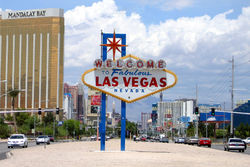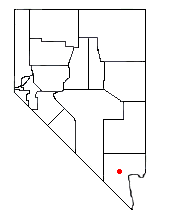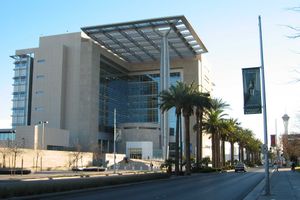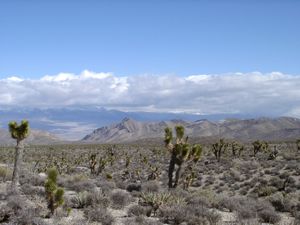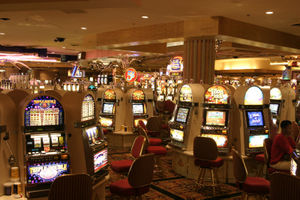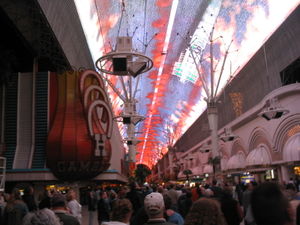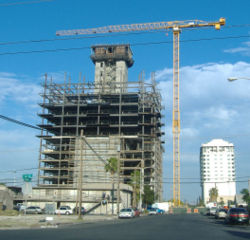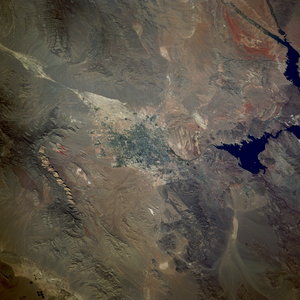Las Vegas, Nevada
2007 Schools Wikipedia Selection. Related subjects: North American Geography
| Las Vegas, Nevada | |||
|
|||
| Nickname: ""The Entertainment Capital of the World"; "Sin City"" | |||
| Location of Las Vegas in Nevada | |||
| Coordinates: | |||
|---|---|---|---|
| County | Clark | ||
| Mayor | Oscar B. Goodman(D) | ||
| Area | |||
| - City | 131.3 mi² / 340.0 km² | ||
| - Land | 131.2 mi² / 339.8 km² | ||
| - Water | 0.1 mi² / 0.26 km² | ||
| Elevation | 610 m | ||
| Population | |||
| - City (2005) | 545,147 | ||
| - Density | 1,604/km² | ||
| - Metro | 1,710,551 | ||
| Time zone | PST ( UTC-8) | ||
| - Summer ( DST) | PDT ( UTC-7) | ||
| Website: http://www.lasvegasnevada.gov/ | |||
Las Vegas (often informally abbreviated to "Vegas") is the most populous city in the state of Nevada, United States, the seat of Clark County, and an internationally known vacation, shopping, entertainment, and gambling destination. It was established in 1905 and officially became a city in 1911. It is the largest U.S. city founded in the 20th century.
The name Las Vegas is often applied to the unincorporated areas of Clark County that surround the city, especially the resort areas on and near the Las Vegas Strip. This 4½ mi (7.2 km) stretch of Las Vegas Boulevard is mostly outside the Las Vegas city limits, in the unincorporated town of Paradise.
The centre of gambling in the United States, Las Vegas is marketed as The Entertainment Capital of the World, also commonly known as Sin City or Vice City, due to the popularity of legalized gambling, availability of alcoholic beverages at any time (as is true throughout Nevada), and various forms and degrees of adult entertainment. The city's glamorous image has made it a popular setting for films and television programs.
History
Founding
Las Vegas (English: "The Meadows" or "The Grasslands") was given its name by Spaniards in the Antonio Armijo party, who used the water in the area while heading north and west along the Old Spanish Trail from Texas. In the 1800s, areas of the Las Vegas Valley contained artesian wells that supported extensive green areas or Meadows (Vega in Spanish), hence the name Las Vegas. John C. Frémont traveled into the Las Vegas Valley on May 3, 1844, while it was still part of Mexico. He was a leader of a group of scientists, scouts and observers for the United States Army Corps of Engineers. On May 10, 1855, following annexation by the United States, Brigham Young assigned 30 Mormon missionaries led by William Bringhurst to the area to convert the Paiute Indian population. A fort was built near the current downtown area, serving as a stopover for travelers along the " Mormon Corridor" between Salt Lake and the briefly thriving Mormon colony at San Bernardino, California. Las Vegas was established as a railroad town on May 15, 1905, when 110 acres (44.5 ha) owned by Montana Senator William A. Clark's San Pedro, Los Angeles and Salt Lake City Railroad, was auctioned off in what is now downtown Las Vegas. Las Vegas was part of Lincoln County until 1909 when it became part of the newly established Clark County. Las Vegas became an incorporated city on March 16, 1911 when it adopted its first charter.
Major events
Las Vegas is one of the most dynamic cities in the world, "reinventing" itself as a gambling mecca, family destination, capital of hedonism ("What happens in Vegas stays in Vegas"), or hotspot for dining and shopping over the years. Several events stand out as turning points:
- The floods of 1955, 1984, 1999, and 2003.
- Establishment of Las Vegas as a railroad town ( May 15, 1905).
- Legalization of gambling ( March 19, 1931).
- Completion of Hoover Dam ( October 9, 1936).
- Opening of Bugsy Siegel's Flamingo Hotel on what would become the Las Vegas Strip ( December 26, 1946).
- Atmospheric nuclear testing ( 1951 to 1962).
- The first Strip property " The El Rancho" was consumed by fire on July 17, 1960.
- Elvis Presley returns to live performances in August 31, 1969 by opening the International Hotel
- MGM Grand Hotel fire the worst disaster in Nevada history on ( November 21, 1980).
- A series of explosions destroys the PEPCON rocket fuel plant and nearby Kidd and Co. marshmallow factory (May 4, 1988)
- Opening of The Mirage which began the era of megaresort casinos on ( November 22, 1989).
- The Dunes became the first Strip property to be imploded on October 27, 1993.
- 100th birthday, or Centennial, of Las Vegas ( May 15, 2005).
Economic history
Las Vegas started as a stopover on the pioneer trails to the west and became a popular railroad town in the early 1900s. It was a staging point for all the mines in the surrounding area, especially those around the town of Bullfrog, that shipped their goods out to the rest of the country. With the growth of the railroads, Las Vegas became less important, but the completion of the nearby Hoover Dam resulted in substantial growth in tourism, which, along with the legalization of gambling, led to the advent of the casino-hotels for which Las Vegas is famous.
The constant stream of tourist dollars from the hotels and casinos was augmented by a new source of federal money. This money came from the establishment of what is now Nellis Air Force Base. The influx of military personnel and casino job-hunters helped start a land building boom which still goes on today..
Law and government
The Las Vegas Metropolitan Police Department provides most law enforcement services in the city and surrounding county. Exceptions include cities with their own law enforcement agency; including North Las Vegas, Henderson and Boulder City.
Most of the people and businesses who live in what they call "Las Vegas" are actually residents of neighboring unincorporated communities or incorporated cities. In fact, of the over 1.7 million people who live in the Las Vegas valley, only 575,973 live inside Las Vegas city limits. The largest suburbs are Paradise (188,768) between Las Vegas and Henderson (224,829), Sunrise Manor (184,801) east of Las Vegas and North Las Vegas, and Spring Valley (161,286) southwest of Las Vegas. Paradise, Sunrise Manor, and Spring Valley are unincorporated townships, while Henderson and North Las Vegas are incorporated. The earliest, Paradise, formed during a 1940s water dispute between the City of Las Vegas and early homeowners south of San Francisco Street, now Sahara Avenue.
The City of Las Vegas government operates as a council-manager government. The Mayor sits as a Councilmember-At-Large and presides over all of the City Council meetings. In the event that the Mayor cannot preside over a City Council meeting, the Mayor Pro-Tem is the presiding officer of the meeting until such time as the Mayor returns to his seat. The City Manager is responsible for the administration and the day-to-day operation of all of the municipal services and city departments. The City Manager also maintains intergovernmental relationships with federal, state, county and other local governments.
A Paiute Indian reservation occupies about 1 acre (4000 m²) in the downtown area of Las Vegas.
City council
( Councilmembers' official city websites are also available)
- Oscar B. Goodman – Mayor and Councilmember at Large (Term Expires in 2007)
- Gary Reese – Mayor Pro-Tem and 3rd Ward Councilmember (Term Expires in 2007)
- Lois Tarkanian – 1st Ward Councilmember (Term Expires in 2007)1
- Steve Wolfson, Esq – 2nd Ward Councilmember (Term Expires in 2009)
- Larry Brown – 4th Ward Councilmember (Term Expires in 2009)
- Lawrence Weekly – 5th Ward Councilmember (Term Expires in 2007)
- Steve Ross – 6th Ward Councilmember (Term Expires in 2009)
1 Elected on January 26, 2005 in a special election to replace Councilwoman Janet Moncrief who was recalled from office.
Lois Tarkanian will serve the remaining two years of the Ward 1 seat.
City management
- Douglas Selby – City Manager
- Barbara Jo (Roni) Ronemus – City Clerk
Government offices
| City of Las Vegas Government Offices 400 Stewart Avenue Las Vegas, NV 89101 |
Metropolitan Police Department 400 Stewart Avenue Las Vegas, NV 89101 |
Detention Centre (City jail) (not the Clark County Detention Centre) 3200 Stewart Avenue Las Vegas, NV 89101 |
Marriage licenses are filed at the Clark County Courthouse.
Geography
Las Vegas is located at (36.194168, 115.222060) GR1. According to the United States Census Bureau, the city has a total area of 340.0 km² (131.3 mi²). 339.8 km² (131.2 mi²) of it is land and 0.16 km² (0.1 mi²) of it (0.04%) is water.
The city is located in an arid basin surrounded by mountains varying in colour from pink to rust to gray. The Spring Mountains lie to the west. As befits a desert, much of the landscape is rocky and dusty. Within the city, however, there are a great deal of lawns, trees, and other greenery. Due to water resource issues, there is now a movement to encourage xeriscaping instead of lawns. Another part of the water conservation efforts include scheduled watering groups for watering residential landscaping.
Climate
Las Vegas' climate is typical of the Mojave Desert, in which it is located, marked with hot summers, mild winters, abundant sunshine year-round, and very little rainfall. High temperatures in the 90s °F are common in the months of May, June, and September and temperatures normally exceed 100 °F (38 °C) most days in the months of July and August, with very low humidity, frequently under 10%. The hottest temperature ever recorded is 117 °F (47 °C) set twice, on July 19, 2005, at McCarran International Airport and July 24, 1942, at present-day Nellis Air Force Base. Winters are cool and windy, with the majority of Las Vegas' annual 4.49 in (114 mm) of rainfall coming from January to March. Winter daytime highs are normally around 60 °F (16 °C) and winter nighttime lows are usually around 40 °F (4 °C). The coldest temperature ever recorded is 8 °F (-13 °C) set on January 25, 1937, at present-day Nellis Air Force Base. Showers occur less frequently in the Spring or Autumn. July through September, the Mexican Monsoon often brings enough moisture from the Gulf of California across Mexico and into the southwest to cause afternoon and evening thunderstorms. Although winter snow is usually visible from December to May on the mountains surrounding Las Vegas, it rarely snows in the city itself.
Demographics
| City of Las Vegas Population by year |
|
| 1920 | 2,304 |
| 1930 | 5,165 |
| 1940 | 8,422 |
| 1950 | 24,624 |
| 1960 | 64,405 |
| 1970 | 125,787 |
| 1980 | 164,674 |
| 1990 | 258,295 |
| 2000 | 478,434 |
| 2005 | 545,147 |
Las Vegas has been the county seat of Clark County since the formation of the county in 1909. The Census Bureau's official population estimate as of 2005 was 545,147. The city’s Planning and Development Department reported an increase of 41,126 in 2005, for a total population of 575,973. . Recent figures place the population for the Las Vegas metropolitan area, which includes all of Clark County, at over 1.6 million people ( 2004 ), and the region is one of the fastest growing in the United States. Las Vegas was ranked as the 29th largest city in the United States in 2000, but recent estimates suggest that the city's population has since surpassed that of Atlanta, Nashville, Washington, D.C., Louisville, Denver and Boston to place it 22nd in rank. It is likely to surpass Milwaukee and possibly a few other cities to reach the top 20 by the time of the 2010 Census.
As of the census GR2 of 2000, there were 478,434 people, 176,750 households, and 117,538 families residing in the city. The population density was 1,630.3/km² (4,222.5/mi²). There are 190,724 housing units at an average density of 649.9/km² (1,683.3/mi²). The racial makeup of the city was 69.86% White, 10.36% African American, 0.75% Native American, 4.78% Asian, 0.45% Pacific Islander, 9.75% from other races, and 4.05% from two or more races. 23.61% of the population is Hispanic or Latino of any race.
There were 176,750 households out of which 31.9% had children under the age of 18 living with them, 48.3% were married couples living together, 12.2% had a female householder with no husband present, and 33.5% were non-families. 25.0% of all households were made up of individuals and 7.5% had someone living alone who was 65 years of age or older. The average household size was 2.66 and the average family size was 3.20.
In the city the population was spread out with 25.9% under the age of 18, 8.8% from 18 to 24, 32.0% from 25 to 44, 21.7% from 45 to 64, and 11.6% who were 65 years of age or older. The median age was 34 years. For every 100 females there were 103.3 males. For every 100 females age 18 and over, there were 102.5 males.
The median income for a household in the city was $44,069, and the median income for a family was $50,465. Males had a median income of $35,511 versus $27,554 for females. The per capita income for the city was $22,060. About 8.6% of families and 11.9% of the population were below the poverty line, including 15.4% of those under age 18 and 8.3% of those age 65 or over.
As of the 2004 census estimate, the Las Vegas metropolitan area contained over 1.6 million residents, and contains the largest ethnic Hawaiian community outside of Hawaii.
Education
Primary public education is provided by the Clark County School District (CCSD), which is the fifth largest school district in the nation.
Las Vegas does not have any independent four-year university within its city limits. The University of Nevada, Las Vegas is located in Paradise, three miles south of the city limits. The University of Nevada Medical School has a campus near downtown Las Vegas. Several national colleges, including the University of Phoenix, have campuses in the Las Vegas area. Nevada State College and Touro University Nevada are both located in nearby Henderson. The Community College of Southern Nevada has campuses in Las Vegas, North Las Vegas and Henderson
Environmental features
Las Vegas is situated on the arid floor within Clark County. Correspondingly the environment is dominated by desert vegetation and wildlife; however, the setting is also subject to torrential flash floods which the infrastructure of storm sewers has not been able to contain. The rapid pace of urban development beginning in the 1980s has produced more impervious surface and exacerbated the inherent flooding issue. Enabling the rapid population expansion was a major addition to the city's sewage treatment capacity, an event removing a major constraint to population growth in the 1970s. The Sewage treatment expansion resulted from a U.S. Environmental Protection Agency grant funded 208 program to analyse and forecast growth and environmental impacts through the year 2010.
Economy
The primary drivers of the Las Vegas economy have been the confluence of tourism, gaming, and conventions which in turn feed the retail and dining industries. Several companies involved in the manufacture of electronic gaming machines, such as slot machines, are located in the Las Vegas area. In the 2000s retail and dining have become attractions of their own.
Tourism marketing and promotion are handled by the Las Vegas Convention and Visitors Authority, a county wide agency. Its annual Visitors Survey provides detailed information on visitor numbers, spending patterns and resulting revenues .
Las Vegas as the county seat and home to the Lloyd D. George Federal District Courthouse, draws numerous legal service industries providing bail, marriage, divorce, tax, incorporation and other legal services.
The redevelopment listed below shows how the city is trying to diversify the local economy and revitalize the downtown area. The World Market Centre is an example of this.
City redevelopment
When The Mirage, the first Megaresort, opened in 1989, it started a movement of people and construction away from downtown Las Vegas to the Las Vegas Strip. This resulted in a drop in tourism from which the downtown area is still trying to recover.
A concerted effort has been made by city officials to diversify the Las Vegas economy from tourism by attracting light manufacturing, banking, and other commercial interests. The lack of any state individual or corporate income tax and very simple incorporation requirements have fostered the success of this effort.
Having been late to develop an urban core of any substantial size, Las Vegas has retained very affordable real estate prices in comparison to nearby urban centers. Consequently, the city has recently enjoyed an enormous boom both in population and in tourism. However, as a New York Times series on the city reported in 2004, the median price of housing in the Las Vegas Valley is now at or above the nationwide median. The urban area has grown outward so quickly that it is beginning to run into Bureau of Land Management holdings along its edges, increasing land values enough that medium- and high-density development is beginning to occur closer to the core.
As a reflection of the city's rapid growing population, the new Chinatown of Las Vegas was constructed in the early 1990s on Spring Mountain Road. Chinatown initially consisted of only one large shopping centre complex, but the area was recently expanded for new shopping centers that contain various Asian businesses.
With the Strip expansion in the 1990s, downtown Las Vegas began to suffer. The Fremont Street Experience (FSE) was built in an effort to draw tourists downtown. While greatly slowing the decline, it did not stop the decline in tourism and revenue. The multi-level Neonopolis, complete with 11 theaters (managed by Galaxy Theaters, Inc.), was built to offer more retail and services downtown. While there have been changes in ownership and management, Neonopolis has not been able to lease all the space available. As of May 2006, the property has been sold and is under new management. Renovations are under-way to revitalize Neonopolis. Look for new restaurants to open in the late summer to early fall of 2006.
In the early 2000s, some promising signs emerged for downtown Las Vegas. The city successfully lured the Internal Revenue Service to move operations from the far west of the city to a new building downtown that opened in April 2005. The IRS is expected to create a demand for additional businesses in the area, epecially in the daytime hours.
The city purchased 61 acres (247,000 m²) of property from Union Pacific Railroad in 1995 with the goal of creating something that would draw tourists and locals to the downtown area. In 2004 Las Vegas Mayor Oscar Goodman announced plans for the Union Park Development which will include residential and office high-rises, The Lou Ruvo Brain Institute, an academic medical centre, The Smith Centre for the Performing Arts, and a new City Hall. After failed negotiations with The Related Co. on the development of Union Park in October of 2005, San Diego-based Newland Communities was chosen by the city as the new development firm. The Newland contract calls for Dan Van Epp, Newland's regional vice president and former president of the Howard Hughes Corp., to oversee his company's work on Union Park. The Lou Ruvo Brain Institute is expected to be completed in 2007.
Along with the Union Park Development, other promising residential and office developments have begun construction around downtown Las Vegas. New condominium and hotel high rise projects have changed the entire Las Vegas skyline dramatically in recent years. Many large high-rise projects are planned for downtown Las Vegas as well as the Las Vegas Strip. It is expected that high-rise condominium development will transform the downtown area into a vibrant urban centre.
The city council of Las Vegas has agreed on zoning changes on Fremont Street, which allows bars to be closer together duplicating efforts of similar cities, like the Gaslamp Quarter of San Diego. It is expected that this change will bring more tourism and business to the downtown area.
In 2005, on a lot adjacent to the city's 61 ac (247,000 m²), the World Market Centre opened. It is intended to be the nation's and possibly the world's preeminent furniture wholesale showroom and marketplace, and is meant to compete with the current furniture market capital of High Point, North Carolina.
In 2004, the city partnered with Cheetah Wireless Technologies and MeshNetwork to pilot a wide area mobile broadband system. The pilot system is installed downtown, around the Fremont Street Experience.
On October 23, 2006, plans were unveiled to build a World Jewelry Center in Downtown's Union Park. Similar to the World Market Centre, the WJC will be a one stop shop for jewelry trade shows from around the world. The project proposes a 57-story, 815-foot office tower.
Technology business development
Although there are large hospitality and gaming industires in Las Vegas, many technology companies are either being relocated to Las Vegas or are created there. For various reasons, Las Vegas has had a high concentration of technology companies in electronic gaming and telecommunications industries.
Some companies started in Las Vegas but since sold or relocated are:
- Westwood Studios (sold to Electronic Arts)
- Systems Research & Development (Sold to IBM)
- Yellowpages.com (Sold to Bellsouth and SBC)
- MPower Communications
Some current technology companies in southern Nevada are:
- Bigelow Aerospace
- CommPartners
- Datanamics
- eVital Communications
- Petroglyph Games
- SkywireMedia
- Switch Communications
- WorldDoc
- Zappos
Transportation
The CAT Bus is a popular means of public transportation among locals and tourists with various bus routes covering a large portion of the valley. The CAT system carries approximately 175,000 people per weekday, or about 10 percent of the valley's population.
The Las Vegas Monorail runs from the MGM Grand Hotel at the south end of the Strip to the Sahara Hotel at the north end of the Strip.
The street numbering system is divided by the following streets:
- Westcliff Drive, US-95 Expressway, Fremont Street and Charleston Boulevard divides the north-south block numbers from west to east.
- Las Vegas Boulevard divides the east-west streets from the Las Vegas Strip to near the Stratosphere, then Main Street becomes the dividing line from the Stratosphere to the North Las Vegas border, after which the Goldfield Street alignment officially divides east and west.
The McCarran International Airport provides commercial flights into the Las Vegas valley. The airport also serves private aircraft, domestic and international passenger flights, and freight/cargo flights. Although general aviation traffic flies into McCarran International, other airstrips are available.
Intercity bus service to Las Vegas is provided by traditional intercity bus carriers, including Greyhound; many charter services, including Green Tortoise; and several Chinatown bus lines.
Primary roadways into and out of Las Vegas include I-15 (north towards Salt Lake City, Utah, and south towards San Diego, California and Los Angeles), US 93 (north towards Ely, Nevada and Jackpot, Nevada, and south towards Kingman, Arizona) and US 95 (north towards Reno and south towards Searchlight, Nevada), providing access to Interstates I-80 and I-40.
Until 1997, the Amtrak Desert Wind train service ran through Las Vegas using the Union Pacific Railroad (UP) rails that run through the city; Amtrak service to Las Vegas has since been replaced by Amtrak's Thruway Motorcoach bus service. Plans to restore Los Angeles to Las Vegas Amtrak service using a Talgo train have been discussed since the Desert Wind was discontinued. As of 2006, however, no such service has been established.
Union Pacific Railroad (UP) is the only class one railroad to provide rail freight service to the city.
Some groups have proposed the California-Nevada Interstate Maglev line from Las Vegas to Los Angeles in order to ease the incoming and outgoing traffic congestion on I-15.
Culture
Sports
Attractions
The major attractions in Vegas are the casinos. The most famous casinos line Las Vegas Boulevard South, also known as the Las Vegas Strip. There are many casinos in the city's downtown area as well, which was the original focal point of the city's gaming industry in its early days. Several large casinos are also located in the county around the city.
Some of the most notable casinos located downtown are on the Fremont Street Experience and include:
- Golden Nugget
- Four Queens
- Binion's Gambling Hall and Hotel
- Fremont Casino
- Plaza Hotel & Casino
- Las Vegas Club
- Fitzgeralds Las Vegas
- Golden Gate Hotel and Casino
Sister cities
Las Vegas has several Sister Cities:
 Pernik, Bulgaria
Pernik, Bulgaria An San, South Korea
An San, South Korea Huludao, China
Huludao, China Phuket, Thailand
Phuket, Thailand Angeles City, Philippines
Angeles City, Philippines
